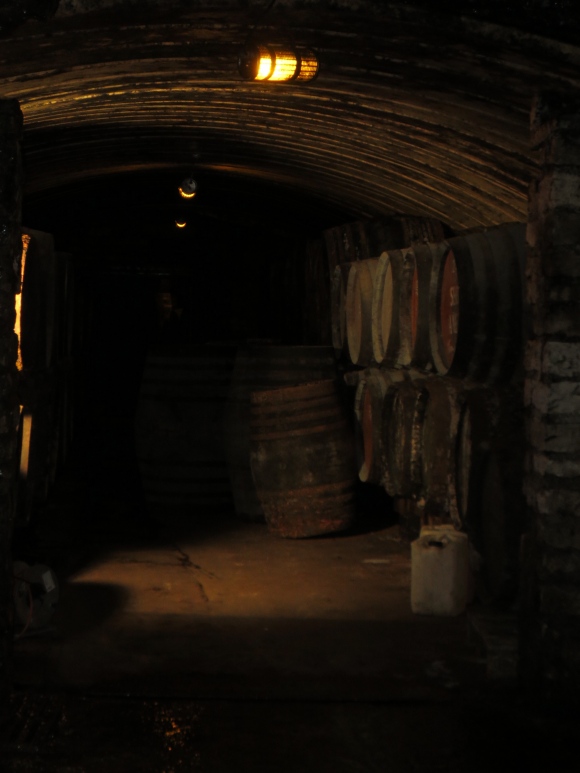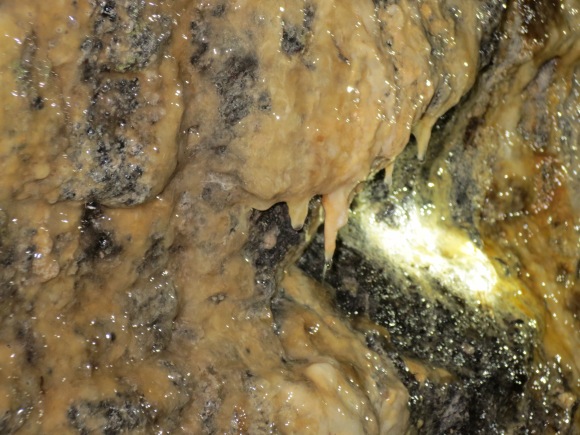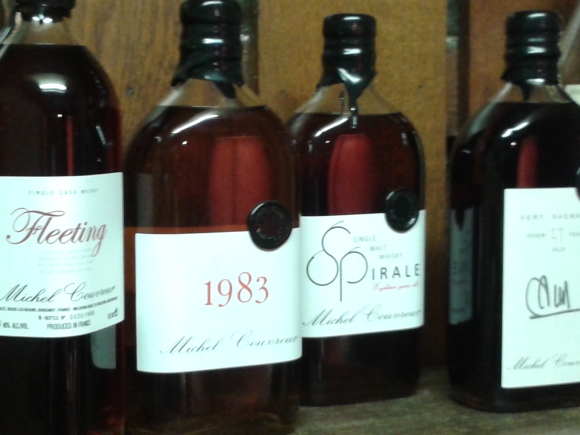A secret treasure lies beneath the little house off the main road in a tiny village in Burgundy. A treasure one wouldn’t expect to find in this region monopolized by the grape vine. A pot of thousands upon thousands of liters of liquid gold.
 Cellars at Michel Couvreur Whisky
Cellars at Michel Couvreur Whisky
Appropriately located, the cellars of Michel Couvreur Scotch Whiskies, a minuscule operation led by a team of 3 dedicated employees, are found in Bouze-les-Beaune. The village is named for the nearby river Bouzaise, named for the Celtic word “bosa”, meaning pocket of water, which later evolved into “bouse” in medieval English, and then the contemporary equivalent, “Booze.” But despite this nominal link to spirits, one would never know what lies in the cellars of the unmarked house.
The cellars, dug out by Michel Couvreur himself to a depth of 15 meters, are a fantasyland evoking an underground scene in The Lord of the Rings. The trickling sound of an underground source fills the damp air and the walls are covered in a wet, slimy substance. A biofilm of microorganisms that seem to thrive in the humid atmosphere, sipping in the alcohol vapors as they grow.
This, according to Blend master Jean-Arnaud Frantzen, is the terroir of the locale of “Finishing,” or the aging of whiskies in 500 L wooden casks. Whether this represents a “true” terroir is of course debatable, but it is clear that the aging environment has an impact. The level of humidity will dictate, by the law of partial pressures, the alcoholic composition of the angel’s share (the portion of a cask’s contents that evaporates over time) and thus of the final alcoholic composition of the whisky remaining in the barrel. But might the environment have even more of an influence than this? Perhaps an influence from the biofilms, which, like the black fungus characterizing the walls of buildings in the region of Cognac, Baudoinia compniacensis (aka Torula compniacensis) flourish in the presence of alcohol vapors? Or the depth below the surface? We all felt a slowing of our own internal rhythms upon descending into this cool, dark space, pressurized place, why couldn’t this have an effect on the whiskies as well?
Biofilms on the cellar walls at Michel Couvreur
But this terroir of “élevage,” as this type of slow, deliberate aging of alcohol is referred to in France, is difficult to pinpoint, difficult to define. All the more complicated by the fact that these whiskies have, in effect, a multiplicity of terroirs. The barley is grown, harvested, and transformed into alcohol in Scotland (and, apparently, individual ‘terroirs’ of barley fields are effectively nonexistent, the ‘taste of place’ not seeming to infuse into a perennial plant that is then severely transformed into a distilled product). The ‘mother’ alcohol is then shipped to France, where it is funneled into specially chosen casks. These casks are full of history, which they subsequently instill into the whisky with which they are impregnated.
Michel Couvreur Whiskies chooses each cask individually. The histories of the casks can be quite varied, but they all contained a potent, richly aromatic wine for a period of 40 to 50 years. The most typically used casks are those of Sherry wines, but also sought-after are variants such as Pedro Ximénez, the local sherry-like wine, Vin Jaune from the Jura region, or Colheita and Tawny Ports. The casks are shipped to Bouze-les-Beaune immediately after being emptied (when regulations allow, Couvreur prefer to ship the casks filled, as dryness is the enemy of wooden casks, making them vulnerable to spoilage and prone to leakage later on) and are refilled, without rinsing or the addition of sulfur, with the mother alcohol. Then the casks are sealed and stocked, for 3, 8, 10, 20… years – as long as it takes to achieve the desired result.
Frantzen adheres to a philosophy of the 8-year plan for whiskies. During the first three years the grains of the original alcohol tend to dominate. Then the whiskies enter the adolescent phase, commencing their maturity but with remaining marks of hotness and youth from the alcohol. Around the 8 year point, the whisky begins to integrate and complexify, ultimately reaching a point of balance – the sweet spot where you aren’t whopped over the head with alcohol when you take a sniff, and you notice a proper level of complexity.
This complexity can be overdone however, spinning out of control and going more towards overwhelming than enjoyable. Towards the end of its life in barrel, the whisky begins to take on more of the aromas that reflect the history of the barrel, seemingly reverting to a reflection of the barrel’s unique aroma fingerprint. This fascinating transformation (that should be carefully considered in attempting to understand the aging processes of any alcoholic beverage, including wine), can, unfortunately, go too far. The sweet spot can give way to earthy, mushroomy, woody, sherry-like aromas that overpower the freshness of the cereals and ultimately destroy the complexity that is so prized in a quality whisky. The difficulty is that the point of maturity, and thus of overripeness, is different for each barrel. Frantzen compares this to individual human beings – we don’t all age at the same rate, with genetics, and more importantly, lifestyle, playing an important role in whether we look and feel our age. Someone who leads a high-stress lifestyle might feel ‘older’ at 40 than an individual who has learned to manage their stress.
My personal favorite name for a whisky, “Intravagan’za” is meant to evoke the complexity, sparkle, explosion of this whisky in the mouth, all with measured restraint, internalizing the extravaganza.
Besides overaging, other factors can lead to imbalance in whisky. The problem is primarily due to attempts to ‘modernize’ the production process, using shortcuts to mature a whisky in a reduced amount of time, and thus turn a profit more quickly. This is the general trend of innovation in whisky production, with some trial being more effective than others. Tests have been run on the fineness of the grind used to produce the base alcohol, with higher surface area thought to give more complexity to the resulting distillate. The use of different yeast strains, as in winemaking and beer brewing, is used to alter the aroma profile of the base alcohol (note that in whisky production, as for beer, spontaneous fermentations by indigenous yeast do not occur as the grains don’t contain sugars that are accessible to these yeasts until starches are broken down by enzymatic processes). Microoxygenation has been considered (though the high alcohol content of the whisky clears the pores of wood casks, rendering even old casks effective microoxygenation systems), though whisky making is a very secretive process, and this method shares a similar, skeptical, reception amongst whisky consumers as it does amongst certain wine consumers (justifiably or not), and thus is not widely communicated about. Some producers use smaller cask (i.e. 50 L instead of the typical 500L used by Couvreur) to increase the surface area of the cask and thus the contact of the whisky with wood and with oxygen. According to Frantzen, this method often results in unbalanced whiskies. Most of this innovation occurs outside of Scotland, as Scotch producers are focused on replicating the consistent quality that they have built a reputation for over the centuries. Thus a producer like Couvreur gives us the opportunity to taste a Scotch that has branched out a bit from its roots (in particular those aged in barrels from Vin Jaune or even Burgundy wines).
And the results? Personally I found them stunning. Frantzen told us that given the origins of the barrels and the complexity that they seek to create at Couvreur, wine aficionados are often particularly apt to appreciate their whiskies. With the two whiskies I was fortunate enough to taste (Overaged Malt Whisky and Blossoming Auld Sherried Single Malt Whisky) I wholeheartedly agree – these are definitely whiskies for wine lovers, and whisky lovers too. Any producer that puts this much passion and care into their product is bound to have a good chance of creating something delicious.
“Fleeting” is the producer’s whisky that is a different blend at each bottling, eternally changing and evolving.





4 replies on “Scottish treasure in Burgundy : A tale of whisky, terroir, and biofilms”
A fascinating report, Alyssa. I had no I dea that such whiskey production is occurring in France. Your photos add a lot to the story too.
I’m puzzled as to why you speak of the vat room as a pressurized place. The elevation in Bouze-lès-Beune is 300-500 meters above sea level. We don’t perceive undue air pressure even at sea level. Unless the vat rooms are hermetically sealed under pressure I don’t see why one would experience in the vat rooms.
Good point Eric – the Blend master spoke of the effects of increased pressure as a result of being underground, and it seemed logical to me at the time that being underground, like being underwater, would result in greater pressure than at ground level. After looking around a bit more online I’m not sure about this… But whether or not the causes are accurate, what he was saying, that being underground is very calming and gives the impression that it slows down your biological rhythms (unless you are claustrophobic, I’m sure). In fact, in my current apartment my bedroom is in what used to be the cellar, and just being a couple of meters underground I feel already these calming effects. Don’t know if its imagined or not, but would be interesting to know more about.
Incredible story and lovely moody pictures. Never knew the origin of word booze till now
Magnifique ! j’habite à qqs kms de là et Michel Couvreur est un de mes clients.Ce que font ces amoureux des belles choses est saisissant. J’invite tous les écossais à venir dans le 21. Vive l’Ecosse et vive la bourgogne !